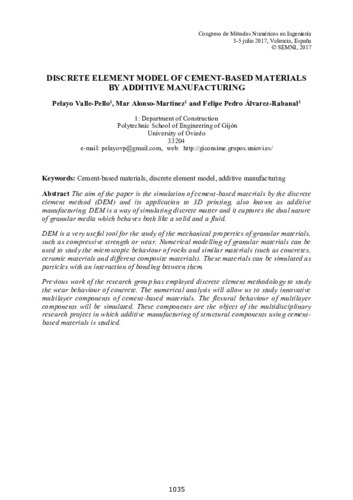Discrete Element Model of Cement-based Materials by Additive Manufacturing
Autor(es) y otros:
Palabra(s) clave:
Cement-based materials
Discrete element model
Additive manufacturing
Fecha de publicación:
Editorial:
International Center for Numerical Methods in Engineering (CIMNE)
Descripción física:
Resumen:
The aim of the paper is the simulation of cement-based materials by the discrete element method (DEM) and its application to 3D printing, also known as additive manufacturing. DEM is a way of simulating discrete matter and it captures the dual nature of granular media which behaves both like a solid and a fluid. DEM is a very useful tool for the study of the mechanical properties of granular materials, such as compressive strength or wear. Numerical modelling of granular materials can be used to study the microscopic behaviour of rocks and similar materials (such as concretes, ceramic materials and different composite materials). These materials can be simulated as particles with an interaction of bonding between them. Previous work of the research group has employed discrete element methodology to study the wear behaviour of concrete. The numerical analysis will allow us to study innovative multilayer components of cement-based materials. The flexural behaviour of multilayer components will be simulated. These components are the object of the multidisciplinary research project in which additive manufacturing of structural components using cement-based materials is studied.
The aim of the paper is the simulation of cement-based materials by the discrete element method (DEM) and its application to 3D printing, also known as additive manufacturing. DEM is a way of simulating discrete matter and it captures the dual nature of granular media which behaves both like a solid and a fluid. DEM is a very useful tool for the study of the mechanical properties of granular materials, such as compressive strength or wear. Numerical modelling of granular materials can be used to study the microscopic behaviour of rocks and similar materials (such as concretes, ceramic materials and different composite materials). These materials can be simulated as particles with an interaction of bonding between them. Previous work of the research group has employed discrete element methodology to study the wear behaviour of concrete. The numerical analysis will allow us to study innovative multilayer components of cement-based materials. The flexural behaviour of multilayer components will be simulated. These components are the object of the multidisciplinary research project in which additive manufacturing of structural components using cement-based materials is studied.
ISBN:
Colecciones
Ficheros en el ítem





